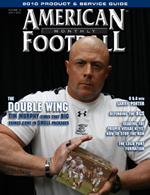AMERICAN FOOTBALL MONTHLY THE #1 RESOURCE FOR FOOTBALL COACHES
|
|
Article Categories
|
An Offense For the Undersized: The Double Wingby: David Purdum© More from this issueIn 1999, Ygnacio Valley High School, under the direction of head coach Tim Murphy, set the all-time large-school record in Northern and Central California by rushing for 5,019 yards. The Warriors’ offensive line that season averaged 208 pounds.
In 2003, Murphy led Clovis East High School to the California Interscholastic Federation title and finished ranked in the Top 25 in the nation. The T-Wolves’ offensive line averaged 198 pounds.
In 2007, Clovis East rushed for just under 5,000 yards with an O-line that averaged 205.
How is Murphy able to produce such prolific rushing attacks with such undersized players? It’s simple – the Double Wing offense, one of the best talent equalizers in the game.
Featuring two tight ends, two wings and a fullback, the Double Wing offense is built around a longtime foot....The full article can only be seen by subscribers.
Subscribe today!

|
|
|
NOT A SUBSCRIBER?
Subscribe
now to start receiving our monthly magazine PLUS get INSTANT
unlimited access to over 4000 pages of 100 percent football coaching
information, ONLY available at AmericanFootballMonthly.com!
|
|
|
HOME
|
MAGAZINE
|
SUBSCRIBE
|
ONLINE COLUMNISTS
|
COACHING VIDEOS
|
Copyright 2025, AmericanFootballMonthly.com
All Rights Reserved






